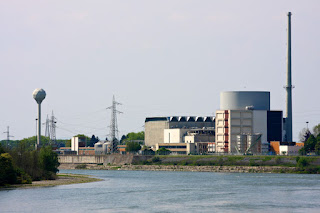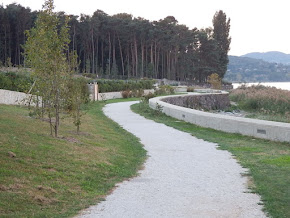NEW - Italy’s first nuclear reactor opens
Facility based on pioneer Enrico Fermi’s historic Chicago-Pile series
The first nuclear reactor to be built on Italian soil was inaugurated on this day in 1959 at Ispra, a small town on the eastern shore of Lago Maggiore. The facility, which preceded the first generation of nuclear power plants serving the need for clean, reliable and plentiful electricity sources for industrial and domestic use, was built purely for research purposes. It was opened four years ahead of the country’s first commercial nuclear plant, at Latina in Lazio. The 5 megawatt Ispra-1 research reactor, as it was titled, was modelled on the latest version of the Chicago-Pile 5 series developed by Enrico Fermi, the Rome-born nuclear physicist who created the world’s first nuclear reactor, the Chicago-Pile 1, following his discovery that if uranium neutrons were emitted into fissioning uranium, they could split other uranium atoms, setting off a chain reaction that would release enormous amounts of energy. The Ispra-1 reactor was built by Italy’s National Nuclear Research Council. It was officially transferred to the European Community in March 1961, becoming a Joint Research Centre (JRC) of the European Commission. Read more…
_______________________________________
Filippo Brunelleschi – architect
Genius who designed the largest brick dome ever constructed
One of the founding fathers of the Renaissance, Filippo Brunelleschi died on this day in 1446 in Florence. He is remembered for developing a technique for linear perspective in art and for building the dome of Florence Cathedral. However, his achievements also included sculpture, mathematics, engineering and ship design. Brunelleschi was born in 1377 in Florence. According to his biographer, Antonio Manetti, and the historian Giorgio Vasari, his father was Brunellesco di Lippo, a notary. Filippo’s education would have equipped him to follow in his father’s footsteps but because he was artistically inclined he was enrolled in the silk merchants guild, which also included goldsmiths and metal workers, and he became a master goldsmith in 1398. In 1401 he entered a competition to design a new set of bronze doors for the Baptistery in Florence. His entry and that of Lorenzo Ghiberti are the only two to have survived. In the first few years of the 15th century, Brunelleschi and his friend, Donatello, visited Rome together to study the ancient ruins. It is believed they were the first to study the physical fabric of the ruins in any detail. Read more…
_____________________________________
Giovanni Amendola - journalist and politician
Liberal writer died following attack by Mussolini’s thugs
Giovanni Amendola, a dedicated opponent of Fascism, was born on this day in 1882 in Naples in southern Italy. As a critic of the right wing extremists in Italy, Amendola had to suffer a series of attacks by hired thugs. He endured a particularly brutal beating in 1925 by 15 Blackshirts armed with clubs near Montecatini Terme in Tuscany and he later died as a result of his injuries, becoming one of the earliest victims of the Fascist regime. Amendola had obtained a degree in philosophy and contributed to the newspapers, Il Leonardo and La Voce, expressing his philosophical and ideological views. He was given the chair of theoretical philosophy at the University of Pisa but, attracted by politics, he stood for parliament and was elected to the Chamber of Deputies three times to represent Salerno. He began contributing to Il Resto di Carlino and Corriere della Sera, urging Italy’s entry into World War I in 1915. He then fought as a volunteer, reaching the rank of captain and winning a medal for valour. Amendola supported the Italian Liberal movement but was completely against the ideology of prime minister Giovanni Giolitti. Read more…
____________________________________
Leonardo da Vinci – painter and inventor
Artist regarded as most talented individual ever to have lived
Leonardo da Vinci, painter, draughtsman, sculptor, architect and engineer, was born on this day in 1452 near Vinci in Tuscany. Leonardo’s genius epitomises the Renaissance ideal of possessing all-round accomplishments and his wall painting of The Last Supper and portrait of the Mona Lisa are among the most popular and influential artworks of all time. His surviving notebooks reveal a spirit of scientific enquiry and a mechanical inventiveness that were centuries ahead of their time. Leonardo received an elementary education but must have shown early artistic inclinations because his father apprenticed him to Andrea del Verrocchio in Florence when he was 15, in whose workshop he was trained in painting and sculpting. There are many superb pen and pencil drawings still in existence from this period, including sketches of military weapons and apparatus. Some of Leonardo’s drawings have been widely reproduced over the centuries and are now even used on T-shirts and coins. Leonardo moved to Milan in 1482 to work for the Duke, Ludovico Sforza, where he was listed as both a court painter and engineer. In addition to his works of art, he designed court festivals and advised on architecture and fortifications. Read more…
_____________________________________
Jacopo Riccati – mathematician
Venetian nobleman who was fascinated by Maths
Respected mathematician Jacopo Francesco Riccati, who had an equation named after him, died on this day in 1754 in Treviso. He had devoted his life to the study of mathematical analysis, turning down many prestigious academic posts offered to him. He is chiefly remembered for the Riccati differential equation, which he spent many years studying. Riccati was born in 1676 in Venice. His father, Conte Montino Riccati, was from a noble family of landowners and his mother was from the powerful Colonna family. His father died when Riccati was only ten years old, leaving him a large estate at Castelfranco Veneto. Riccati was educated first at the Jesuit school for the nobility in Brescia and in 1693 went to the University of Padua to study law. After receiving a doctorate in law in 1696 he began to study mathematical analysis. He was invited to Russia by Peter the Great to be president of the St Petersburg Academy of Sciences, also to Vienna to be an imperial councillor, and he was offered a professorship at the University of Padua, but he declined them all, preferring to remain on his estate with his family studying on his own. Read more…
.jpg)



.jpg)


.jpg)

.jpg)




.jpg)

